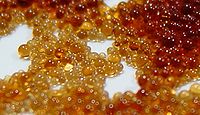- Ion exchange
-
Ion exchange is an exchange of ions between two electrolytes or between an electrolyte solution and a complex. In most cases the term is used to denote the processes of purification, separation, and decontamination of aqueous and other ion-containing solutions with solid polymeric or mineralic 'ion exchangers'.
Typical ion exchangers are ion exchange resins (functionalized porous or gel polymer), zeolites, montmorillonite, clay, and soil humus. Ion exchangers are either cation exchangers that exchange positively charged ions (cations) or anion exchangers that exchange negatively charged ions (anions). There are also amphoteric exchangers that are able to exchange both cations and anions simultaneously. However, the simultaneous exchange of cations and anions can be more efficiently performed in mixed beds that contain a mixture of anion and cation exchange resins, or passing the treated solution through several different ion exchange materials.
Ion exchangers can be unselective or have binding preferences for certain ions or classes of ions, depending on their chemical structure. This can be dependent on the size of the ions, their charge, or their structure. Typical examples of ions that can bind to ion exchangers are:
- H+ (proton) and OH− (hydroxide)
- Single-charged monatomic ions like Na+, K+, and Cl−
- Double-charged monatomic ions like Ca2+ and Mg2+
- Polyatomic inorganic ions like SO42− and PO43−
- Organic bases, usually molecules containing the amino functional group -NR2H+
- Organic acids, often molecules containing -COO− (carboxylic acid) functional groups
- Biomolecules that can be ionized: amino acids, peptides, proteins, etc.
Ion exchange is a reversible process and the ion exchanger can be regenerated or loaded with desirable ions by washing with an excess of these ions.
Contents
Applications
Ion exchange is widely used in the food & beverage, hydrometallurgical, metals finishing, chemical & petrochemical, pharmaceutical, sugar & sweeteners, ground & potable water, nuclear, softening & industrial water, semiconductor, power, and a host of other industries.
Most typical example of application is preparation of high purity water for power engineering, electronic and nuclear industries; i.e. polymeric or mineralic insoluble ion exchangers are widely used for water softening, water purification, water decontamination, etc.
Ion exchange is a method widely used in household (laundry detergents and water filters) to produce soft water. This is accomplished by exchanging calcium Ca2+ and magnesium Mg2+ cations against Na+ or H+ cations (see water softening).
Industrial and analytical ion exchange chromatography is another area to be mentioned. Ion exchange chromatography is a chromatographical method that is widely used for chemical analysis and separation of ions. For example, in biochemistry it is widely used to separate charged molecules such as proteins. An important area of the application is extraction and purification of biologically produced substances such as proteins (amino acids) and DNA/RNA.
Ion-exchange processes are used to separate and purify metals, including separating uranium from plutonium and other actinides, including thorium, and lanthanum, neodymium, ytterbium, samarium, lutetium, from each other and the other lanthanides. There are two series of rare earth metals, the lanthanides and the actinides, both of whose families all have very similar chemical and physical properties. Using methods developed by Frank Spedding in the 1940s, ion-exchange used to be the only practical way to separate them in large quantities, until the advent of solvent extraction techniques that can be scaled up enormously.
A very important case is the PUREX process (plutonium-uranium extraction process), which is used to separate the plutonium and the uranium from the spent fuel products from a nuclear reactor, and to be able to dispose of the waste products. Then, the plutonium and uranium are available for making nuclear-energy materials, such as new reactor fuel and nuclear weapons.
The ion-exchange process is also used to separate other sets of very similar chemical elements, such as zirconium and hafnium, which is also very important for the nuclear industry. Zirconium is practically transparent to free neutrons, used in building reactors, but hafnium is a very strong absorber of neutrons, used in reactor control rods.
Ion exchangers are used in nuclear reprocessing and the treatment of radioactive waste.
Ion exchange resins in the form of thin membranes are used in chloralkali process, fuel cells and vanadium redox batteries. Ion exchange can also be used to remove hardness from water by exchanging calcium and magnesium ions for hydrogen and chlorine ions in an ion exchange column.
Other applications
- In soil science, cation exchange capacity is the ion exchange capacity of soil for positively charged ions. Soils can be considered as natural weak cation exchangers.
- In planar waveguide manufacturing, ion exchange is used to create the guiding layer of higher index of refraction.
- Dealkalization, removal of alkali ions from a glass surface.
- Chemically strengthened glass, produced by exchanging Na+ for K+ in glass surfaces using KNO3 melts.
See also
- Alkali anion exchange membrane
- Ion-exchange resin
External links
Categories:
Wikimedia Foundation. 2010.



